Related Research Articles
Rudolph Carl Gorman was a Native American artist of the Navajo Nation. Referred to as "the Picasso of American Indian artists" by The New York Times, his paintings are primarily of Native American women and characterized by fluid forms and vibrant colors, though he also worked in sculpture, ceramics, and stone lithography. He was also an avid lover of cuisine, authoring four cookbooks, called Nudes and Food.
The National Heritage Fellowship is a lifetime honor presented to master folk and traditional artists by the National Endowment for the Arts. Similar to Japan's Living National Treasure award, the Fellowship is the United States government's highest honor in the folk and traditional arts. It is a one-time only award and fellows must be living citizens or permanent residents of the United States. Each year, fellowships are presented to between nine and fifteen artists or groups at a ceremony in Washington, D.C.

A santo is a piece of one of various religious art forms found in Spain and areas that were colonies of the Kingdom of Spain, consisting of wooden or ivory statues that depict various saints, angels, or Marian titles, or one of the personages of the Holy Trinity. A santero is a craftsperson who makes the image. Some santos which have gained greater public devotion among the faithful have also merited papal approval through canonical coronations. Santos remain a living tradition of religious iconography and folk art in Mexico, the Philippines, Puerto Rico and some other Caribbean islands, South and Central America, and the Southwestern United States, especially New Mexico.
Luis Alfonso JiménezJr. was an American sculptor and graphic artist of Mexican descent who identified as a Chicano. He was known for portraying Mexican, Southwestern, Hispanic-American, and general themes in his public commissions, some of which are site specific. The most famous of these is his Mustang. It was commissioned by the Denver International Airport and completed after his death.
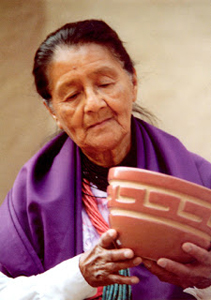
Maria Margarita "Margaret" Tafoya was the matriarch of Santa Clara Pueblo potters. She was a recipient of a 1984 National Heritage Fellowship awarded by the National Endowment for the Arts, which is the United States government's highest honor in the folk and traditional arts.
Marie Zieu Chino (1907–1982) was a Native American potter from Acoma Pueblo, New Mexico. Marie and her friends Lucy M. Lewis and Jessie Garcia are recognized as the three most important Acoma potters during the 1950s. Along with Juana Leno, they have been called "The Four Matriarchs" who "revived the ancient style of Acoma pottery." The inspiration for many designs used on their pottery were found on old potsherds gathered to use for temper. Together they led the revival of ancient pottery forms including the Mimbres, Tularosa and other various cultures in the Anasazi region. This revival spread to other potters who also accepted the old styles, which led to new innovative designs and variations of style and form.
Mari Lyn Salvador was an American anthropologist, known for her work on Panamanian molas, worn by Kuna women. She became the director of the San Diego Museum of Man and the Hearst Museum of Anthropology. Salvador's career focused on analysis of ethnoaesthetics, or the appreciation of art in its own cultural context, from a variety of peoples.
Kenneth Miller Adams was an American artist.
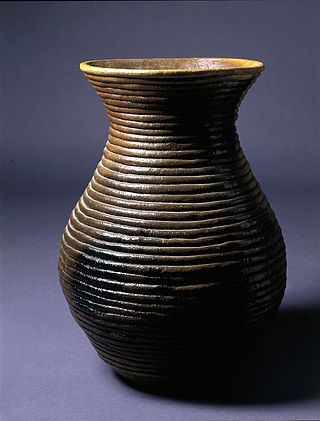
Louise Rose Goodman is a Navajo folk artist and ceramicist.
Nicholas Herrera (born July 11, 1964) is an artist in the Northern New Mexico Santero tradition, also known as El Rito Santero.
Alice Williams Cling is a Native American ceramist and potter known for creating beautiful and innovative pottery that has a distinctive rich reds, purples, browns and blacks that have a polished and shiny exteriors, revolutionizing the functional to works of art. Critics have argued that she is the most important Navajo potter of the last 25 years.
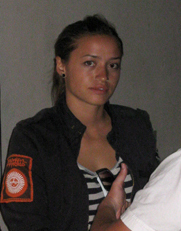
Rose B. Simpson is a mixed-media artist who works in ceramic, metal, fashion, painting, music, performance, and installation. She lives and works in Santa Clara Pueblo, New Mexico. Her work has been exhibited at SITE Santa Fe ; the Heard Museum ; the Museum of Contemporary Native Art, Santa Fe (2010); the National Museum of the American Indian, Smithsonian (2008); the Denver Art Museum; Pomona College Museum of Art (2016); Ford Foundation Gallery (2019); The Wheelwright Museum of the American Indian (2017); the Minneapolis Institute of Art (2019); the Savannah College of Art and Design (2020); and the Nevada Museum of Art (2021).
Christine McHorse, also known as Christine Nofchissey McHorse, was a Navajo ceramic artist from Santa Fe, New Mexico.
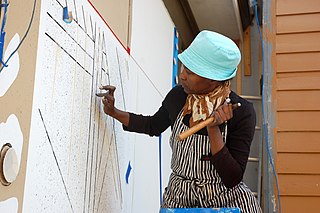
Alicia Henry is a contemporary artist living, working and teaching in Nashville. Henry is an associate professor in the Language and Arts Department at Fisk University. Henry creates multi-media artwork that focuses on themes of the body and identity. She uses materials such as wood, fabric, paper and pigment for her creations. Henry has a Bachelor of Fine Arts from The School of the Art Institute of Chicago and a Master of Fine Arts from the School of Art at Yale University.
Bernadette Vigil is an American artist and illustrator whose work has been exhibited in museums and galleries nationally and abroad. She has produced permanent public artworks in the form of fresco murals for the cities of Santa Fe and Albuquerque, New Mexico. She has been commissioned to create religious frescoes in churches in New Mexico, and has been called a "master of the art of buon fresco" in the Santos Tradition. She has authored a book on Toltec spirituality, Mastery of Awareness: Living the Agreements. In 2002 it was published in Spanish as El Dominio de la Conciencia, and in 2005 it was published in German as Das Geheimnis der vier Versprechen.
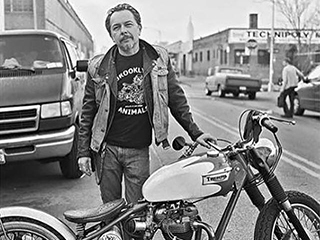
Ray Martìn Abeyta was an American painter. His paintings are a hybrid of ancient and contemporary Latino subject matter in the Cuzco School style of Madonna painting, lowrider culture, New Mexican traditional retablo painting, and representations of the colonialist encounters between Europeans and Mesoamericans.
Eve Aschheim is an American draftsperson and painter.
Juanita Jaramillo Lavadie is a contemporary weaver, textile scholar and muralist based in New Mexico. Her art is centered on the acequia system in Taos County, Northern, New Mexico and is influenced by traditional Hispano and Indigenous cultures. Her work primarily focuses on water rights in Taos County.
Nyugen Smith is an American artist and educator based in Jersey City whose works responds to the legacy of European colonial rule in African diaspora and considers imperialist practices of oppression, violence, and intergenerational trauma. Smith's work has been featured in exhibitions at key galleries and museums which include the El Museo del Barrio and the Pérez Art Museum Miami.
Pola Lopez is a painter and muralist known for her abstract, southwestern-inspired artworks.
References
- ↑ Hagerty, Donald (1997). Leading the West : one hundred contemporary painters and sculptors. Flagstaff, Arizona: Northland Publishing. p. 202. ISBN 087358600X.
- ↑ Rosenak, Chuck and Jan (1998). The Saint Makers : Contemporary Santeras y Santeros . Flagstaff, AZ: Northland Publishing. p. 127. ISBN 0873587189.
- ↑ Montaño, Mary (2001). Tradiciones Nuevomexicanas : Hispano Arts and Culture of New Mexico. Albuquerque: University of New Mexico Press. p. 53. ISBN 0826321372.
- ↑ Beardsley, John; Livingston, Jane (1987). Hispanic Art in the United States : Thirty Contemporary Painters and Sculptors. New York: Cross River Press. p. 244. ISBN 0896596885.
- ↑ Kalb, Laurie Beth (1994). Crafting Devotions : Tradition in Contemporary New Mexico Santos. Albuquerque: University of New Mexico Press. p. 46. ISBN 978-0826315502.
- ↑ Gomez, Adrian (September 24, 2017). "Sculptor Luis Tapia's works speak to historic and modern Hispanic experience". Albuquerque Journal. Retrieved January 18, 2019.
- ↑ "Past Exhibitions at Albuquerque Museum". Albuquerque Museum. City of Albuquerque. Retrieved June 14, 2019.
- ↑ "Artist Stands Back to Watch Art Happen". Albuquerque Journal. September 12, 1992. Retrieved June 15, 2019.
- ↑ Lewthwaite, Stephanie (2015). A Contested Art: Modernism and Mestizaje in New Mexico. University of Oklahoma Press. p. 108. ISBN 978-0806148649 . Retrieved March 12, 2021.
- ↑ Mercedes Everett, Ethel (2019). "La Cofradía de Artes y Artesanos Hispánicos: Redefining Tradition in the New Mexican Art Market". The City College of New York. Retrieved March 12, 2021.
- ↑ "Joan Mitchell Foundation Announces Inaugural Fellows". www.artforum.com. Retrieved November 19, 2021.
- ↑ "NEA National Heritage Fellowships 2023". www.arts.gov. National Endowment for the Arts. n.d. Retrieved June 24, 2023.